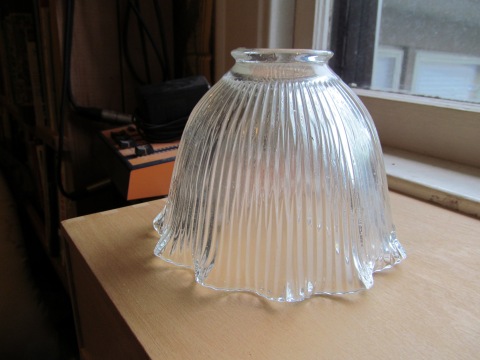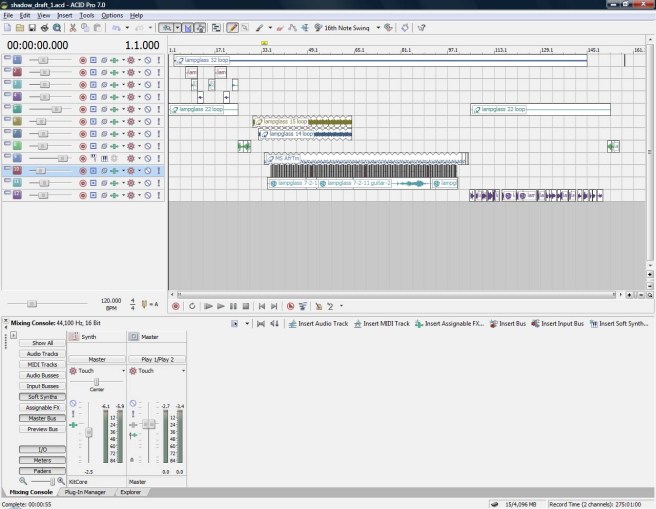
The screen shot for “Shadow” is confusing and misleading. All the track titles are variations of “lamp glass” because initially I was constructing something with all samples created by playing a corrugated light fixture that was once in our dining room and had initially named the ACID file for those samples. Yet the mid-section is Stratocaster and the last third is voice.

Shadow, draft 1, July 2, 2011:
The first eight tracks are loops and one shots from the light fixture recording. All or almost all have been heavily processed in Guitar Rig. The sample on the eighth track (transition from intro and at the end) was run through a simulation of a guitar amp. I think that’s what made me use my Stratocaster, which I hadn’t touched in over a decade (it was untuned and, I think, missing an E string).
The ninth track is a MIDI drum riff that captures a performance by Michael Shrieve. I played it through a different drum kit than was intended (one of the fun things about software drums). I replaced a metal air filter for the steady high hat beat (track ten) to give it more buzz. (I think it was ACID Pro 7 that came with a limited version of KitCore. It took me several years to try it out.)
After stepping out for lunch I recorded the guitar part, not really playing it in any normal sense but scrubbing the remaining strings with a canning lid (Kerr, though I’m sure a Ball lid would have worked just as well). I have no idea what notes I played. But, as I’ve said, the guitar wasn’t in tune so it doesn’t really matter. Yet I’m not the only one who has taken pleasure in this noise. The strings seem to have been abused authoritatively, with finesse and vigor.
If you are an artist and have not yet read Lewis Hyde’s The Gift: Imagination and the Erotic Life of Property I think you should. I was on perhaps my fourth reading of it, the section about Ezra Pound and vegetable money worming through me, while I was working with these sounds. I think we’ve all learned the importance of recognizing our hidden, dark forces (well, I wish all of us had learned that lesson but the world is still full of ignorant people spewing hate because they can’t go there). But these buried things can be over examined. I want to know what’s there but I don’t want to know everything. I want them to surprise me. I’m still willing to make an ass of myself as these cryptic shadows take control of my mouth if it means I can occasionally say something of interest too. I would say that’s the essence of the creative process.
I also wrote the text after lunch.
Shadow
all this light
all this light and cross examination
everything is so plain to see
seen clearly and exactly explained
not a single stain left for the imagination
nothing to do but talk
say what you will
nothing but talk
and more talk
more talk
more talk
just talk
it keeps going around
bright lights
the steady look
then the words
talk talk talk talk talk…
that rapturous rapacious romantic thrill is gone
who do I love
who do I fear
why won’t they touch me anymore
where are my enemies
what happened to suspicion and passion and tall the layers of duplicity
this meeting has turned into an autopsy
everything is so clear
now I’m sane and lifeless
sane
god am I sane
please, turn out the light

One thought on “Number 63: Shadow”